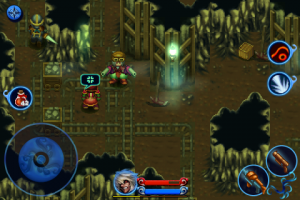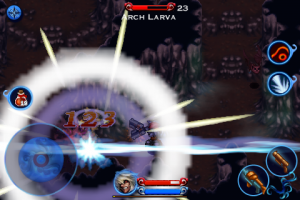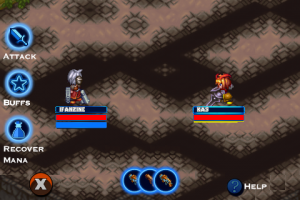 By far the most contentious issue in Heroes Lore III is the nature of its movement controls. Some might be tempted to blame the switch from the traditional four-point virtual D-pad to the virtual joystick for several gameplay imperfections, but I found the virtual joystick’s usage a welcome evolution for the genre. This is the first iOS Action RPG in which I didn’t experience frequent thumb slippage from the control point. On the other hand, this is also the first iOS Action RPG in which I frequently had difficulty navigating the player character along walls and other solid environment objects, as Kei and Rits have an uncanny ability to become glued to these. This struck me more as a flaw in level design and collision handling than a control problem. Moving through expansive areas with lots of breathing room is far easier than navigating tight corridors and alleys, of which there are just a few too many for comfort.
By far the most contentious issue in Heroes Lore III is the nature of its movement controls. Some might be tempted to blame the switch from the traditional four-point virtual D-pad to the virtual joystick for several gameplay imperfections, but I found the virtual joystick’s usage a welcome evolution for the genre. This is the first iOS Action RPG in which I didn’t experience frequent thumb slippage from the control point. On the other hand, this is also the first iOS Action RPG in which I frequently had difficulty navigating the player character along walls and other solid environment objects, as Kei and Rits have an uncanny ability to become glued to these. This struck me more as a flaw in level design and collision handling than a control problem. Moving through expansive areas with lots of breathing room is far easier than navigating tight corridors and alleys, of which there are just a few too many for comfort.
Secondly, transitioning from one area to the next exacts some care on the player’s part. The virtual joystick resets itself when Kei or Rits exit an area, and given the tendency of the player’s thumb to be a bit off center when reaching for the joystick again, the player might accidentally exit the newly-entered area. Greater initial distance between the player character and area entrances might have prevented this. Left handed players may also want to note that there doesn’t appear to be an option for reversing which side of the touchscreen the virtual controls appear on.
 The difficulty players initially experience in guiding Kei and Rits around their world does fade over time. Sticklers for perfect controls may dismiss Heroes Lore III before reaching a comfortable level of familiarity with its quirks, but those who stick with the game should love the dual weapon system. Its side-by-side virtual buttons favorably compare to the attack button scheme used in Samurai II: Vengeance. It’s too bad there’s not nearly as much in the way of triggering special attacks with specific button combinations here. The main advantage to stringing attacks together seems to be pulling off strong/secondary weapon attacks more quickly by inserting them into a string of quick/primary weapon attacks.
The difficulty players initially experience in guiding Kei and Rits around their world does fade over time. Sticklers for perfect controls may dismiss Heroes Lore III before reaching a comfortable level of familiarity with its quirks, but those who stick with the game should love the dual weapon system. Its side-by-side virtual buttons favorably compare to the attack button scheme used in Samurai II: Vengeance. It’s too bad there’s not nearly as much in the way of triggering special attacks with specific button combinations here. The main advantage to stringing attacks together seems to be pulling off strong/secondary weapon attacks more quickly by inserting them into a string of quick/primary weapon attacks.
Heroes Lore III’s online multiplayer mode feels more like a minor curiosity than an integral part of the game, although it does mix things up nicely by trading Action RPG mechanics in for an interesting turn based battle system. At the beginning of a turn the player assigns between one and three attacks to his or her character – sadly, only Kei and Rits are on offer again, possessing whatever equipment and special attacks they have in a single player game save selected while logging into the server.
 Before executing the specified actions the player’s character has to wait for an amount of time proportional to the number and types of attacks selected, meaning that the character will suffer attacks from opponents who choose fewer actions in the meantime. The wait times become reminiscent of the slowly filling ATB bars found in old Final Fantasy titles, but this tends to be less noticeable in hectic two-on-two player competitions than in the more leisurely one-on-one matches. The game server shoops in AI-controlled allies and opponents when nobody else is logged in, and since the single player game comprises the vast bulk of Heroes Lore III, player-vs-AI matches happen more frequently than not. A server ranking system lets the player keep track of how he or she compares to others in terms of victories and defeats.
Before executing the specified actions the player’s character has to wait for an amount of time proportional to the number and types of attacks selected, meaning that the character will suffer attacks from opponents who choose fewer actions in the meantime. The wait times become reminiscent of the slowly filling ATB bars found in old Final Fantasy titles, but this tends to be less noticeable in hectic two-on-two player competitions than in the more leisurely one-on-one matches. The game server shoops in AI-controlled allies and opponents when nobody else is logged in, and since the single player game comprises the vast bulk of Heroes Lore III, player-vs-AI matches happen more frequently than not. A server ranking system lets the player keep track of how he or she compares to others in terms of victories and defeats.
Heroes Lore III sports luscious environment and character portrait art. The sprite art is attractive right up until the sprites actually move; each sprite appears to be strung together from separate components, giving arms and legs a propensity to flop around like unnatural ragdoll appendages. This visual quirk no doubt sprung from the developer’s way of handling Kei’s and Rits’ equipment-dependent appearances, but even so, the sprite animations are uncharacteristically jerky compared to other games that pull off the same equipment effects. Enemy and NPC sprite animations tend to fare better than the player character sprites.
Music is a mixed bag in Heroes Lore III, ranging from an unfortunate jingle-length boss theme to town and dungeon tunes that can be quite catchy. One may silence the game’s music from the preferences menu and use an iTunes playlist if desired.
iFanzine Verdict: Heroes Lore III is one of those games that could have been utterly outstanding if it had better capitalized on its strengths and mitigated its weaknesses. It scores points for innovative plot structure and its lovely dual weapon system, but once control issues and aesthetic choppiness are considered it merely draws even with its competition overall.
Highly recommended for fans of overhead Action RPGs who previously enjoyed titles ranging from Zenonia to Seed II, and who don’t mind a bit of a learning curve when it comes to getting acquainted with a game’s user interface.


